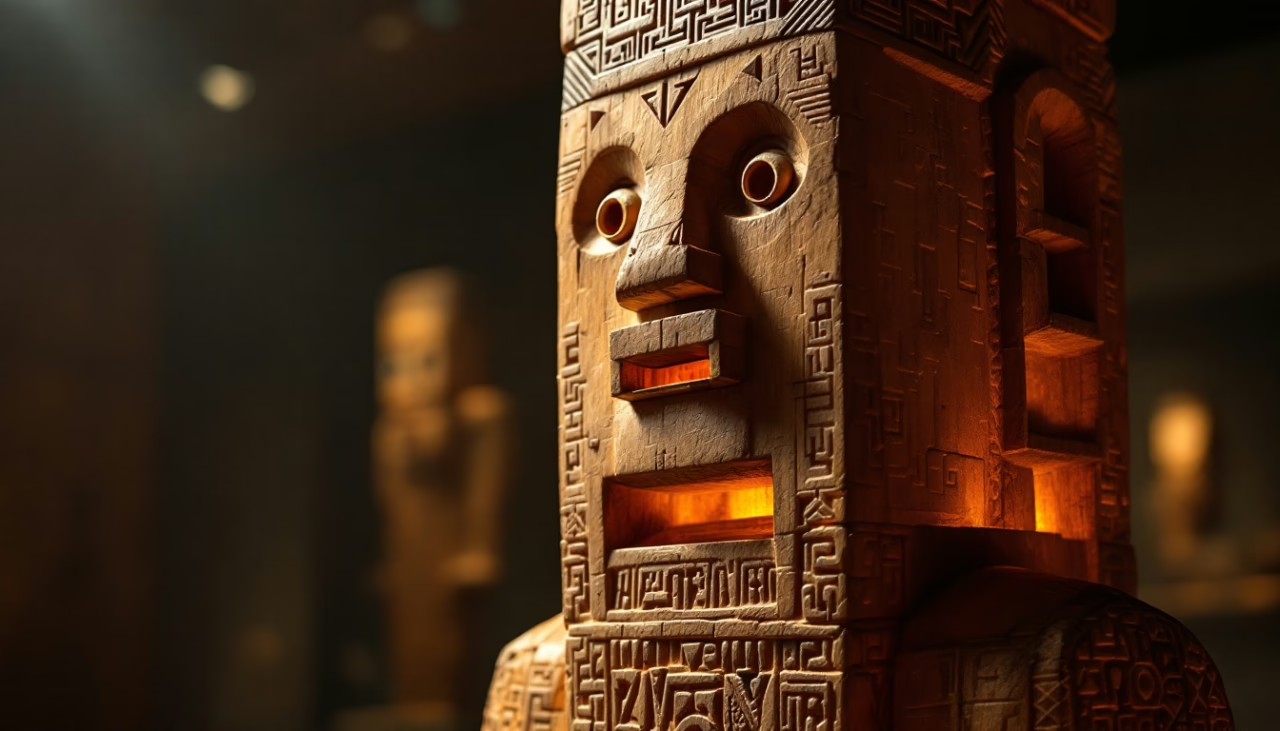Shigir Idol: Europe’s Oldest Wooden Sculpture

The enigmatic Shigir Idol stands as a representation of prehistoric ingenuity, its wooden form defying time’s relentless march.
Discovered in the late nineteenth century, this remarkable sculpture predates Stonehenge by millennia.
Its geometric patterns and haunting faces, meticulously carved by Mesolithic hands, challenge our understanding of ancient artistic capabilities.
What spiritual purpose drove these hunter-gatherers to create such an elaborate monument?
The answer remains shrouded in the same peat bog that preserved this wooden sentinel for twelve thousand years.
TL;DR
Hide- Carved approximately 12,000 years ago, the Shigir Idol is the oldest known wooden sculpture in the world.
- Discovered in 1890 in a Russian peat bog, the sculpture stands over five meters tall in its original form.
- The idol features intricate carvings including geometric patterns, human faces, and enigmatic symbols created with stone tools.
- Its preservation provides unique insights into Mesolithic hunter-gatherer spiritual beliefs and artistic capabilities.
- Recent dating has increased its age by 2,500 years, challenging established timelines of prehistoric artistic development.
Shigir Idol: Historical Discovery and Cultural Significance

The Shigir Idol, unearthed from a peat bog in the Ural Mountains in 1890, represents one of archaeology’s most extraordinary finds—a wooden sculpture that has miraculously survived millennia beneath Russia’s marshy terrain.
Its distinctive features include an elongated humanoid form adorned with cryptic geometric patterns and zigzag carvings that continue to perplex scholars attempting to interpret their symbolic meaning.
This ancient marvel, standing over five meters in its original form, transcends mere artifact status to embody humanity’s enduring impulse to create meaning through art, even in our most distant past.
Discovery in the Ural Mountains
The Shigir Idol emerged from the depths of a peat bog in the Ural Mountains in 1890, when gold miners unexpectedly unearthed what would later be recognized as the world’s oldest wooden sculpture.
Radiocarbon dating, initially suggesting the artifact was 9,500 years old, has recently revealed an even more astonishing age of approximately 12,000 years, fundamentally altering our understanding of Mesolithic artistic capabilities.
This remarkable totem, standing over five meters tall in its original form and covered in enigmatic geometric patterns and human faces, represents an invaluable window into the spiritual and artistic sensibilities of hunter-gatherers who inhabited the region long before the development of agriculture in the Fertile Crescent.
Excavation history and dating methods
Discovery of the Shigir Idol began in January 1890, when gold miners working in the Shigir peat bog near Yekaterinburg in the Ural Mountains of Russia uncovered this remarkable wooden artifact at a depth of approximately four meters.
Initial excavation techniques were rudimentary, though the peat’s anaerobic environment fortuitously preserved the wooden sculpture, presenting dating challenges that modern archaeological methods have since resolved through meticulous radiocarbon analysis.
The artifact’s importance in Neolithic art
Standing as a monumental proof to early human artistic expression, the Shigir Idol revolutionizes scholarly understanding of Neolithic art and challenges long-held assumptions about prehistoric creativity.
This masterpiece exemplifies neolithic expression through its complex symbolic representation of cultural identity, revealing a sophisticated artistic innovation previously unimaginable for its era.
The idol’s intricate patterns transcend mere decoration, embodying the profound prehistoric creativity of our ancestors.
The Shigir Idol’s Unique Features
The Shigir Idol‘s most compelling attributes lie in its extraordinarily intricate carvings, featuring geometric patterns, human faces, and enigmatic symbols whose meanings remain tantalizingly obscure to modern scholars.
These markings, etched with remarkable precision into larchwood by Stone Age artisans using primitive stone tools, represent an unprecedented level of Mesolithic artistic sophistication.
The exceptional preservation of the idol’s organic material, surviving millennia in the oxygen-poor peat bog environment, provides archaeologists with rare insights into prehistoric construction techniques, including evidence of polishing, smoothing, and joining methods that challenge conventional understanding of early human technological capabilities.
Intricate carvings and mysterious symbols
Carved meticulously into ancient larch wood, the intricate geometric patterns and enigmatic faces of the Shigir Idol represent one of the most sophisticated examples of Mesolithic art ever discovered.
Its intricate symbolism features seven distinct faces and complex zigzag lines, showcasing remarkable ancient craftsmanship through artistic techniques that scholars link to mythological connections and spiritual cultural interpretations from our distant past.
Construction techniques and material preservation
Despite spending millennia submerged in peat bog conditions, the Shigir Idol‘s remarkable preservation reveals sophisticated construction techniques employed by Mesolithic craftspeople who lived in the Ural Mountain region approximately 12,000 years ago.
Modern material degradation studies highlight how ancient carving methods utilized specialized stone tools, while environmental impact analysis demonstrates how waterlogged conditions paradoxically protected this artifact through unique wood preservation techniques that contemporary sustainable archaeology practices now emulate.
Artistic and Symbolic Analysis
The enigmatic carvings adorning the Shigir Idol present a complex symbolic language that has challenged archaeologists and art historians for over a century.
Scholars have identified geometric patterns, human-like faces, and abstract symbols that bear striking similarities to other Mesolithic artifacts discovered across Europe, particularly those found in Scandinavia and the Baltic regions.
These artistic elements, executed with remarkable precision using stone tools, suggest a sophisticated symbolic system that potentially communicated cosmological beliefs, tribal identities, or narrative elements of now-lost mythologies.
Interpretation of the Carvings
The intricate carvings adorning the Shigir Idol have prompted scholars to propose various interpretations, with strong evidence suggesting shamanistic and religious significance embodied in the geometric patterns and enigmatic faces.
These mysterious symbols—zigzags, lines, and anthropomorphic figures carved with remarkable precision—likely represent a complex cosmological system, possibly depicting the structure of the universe as understood by ancient forest dwellers of the Urals.
Researchers continue to examine the abstract representations through comparative analysis with other Mesolithic art, revealing potential connections to astronomical observations, spirit worlds, and the natural rhythms that governed prehistoric spiritual life.
Possible shamanistic and religious meanings
Mysterious zigzags, geometric patterns, and anthropomorphic faces carved into the ancient larch surface of the Shigir Idol likely encode sophisticated shamanistic beliefs and religious symbolism that scholars are still working to decipher.
These markings may represent portals between worlds, cosmic hierarchies central to ritual practices, or cultural mythology linking ancestral spirits to the living—reflecting an ancient spirituality that resonated across the Eurasian steppe.
Theories on abstract representations
While conventional archaeological interpretation often focuses on literal meanings, abstract representations carved into the Shigir Idol suggest a far more complex symbolic language that transcends mere decoration.
The idol’s abstract symbolism challenges modern cultural interpretation frameworks, presenting a visual language that invites multiple readings. This deliberate meaning abstraction likely represents sophisticated artistic expression, communicating ideas that resonated deeply within Mesolithic spiritual consciousness.
Comparisons with Other Prehistoric Artifacts
The Shigir Idol shares notable artistic elements with other Neolithic artifacts from across Eurasia, particularly in its geometric patterns and anthropomorphic features that echo similar motifs found in sites from the Urals to Western Europe.
When placed in the broader context of prehistoric art, the idol emerges not as an isolated curiosity but as an essential piece in understanding the complex symbolic language that early humans developed to interpret their world.
Its distinctive zigzag carvings and expressive faces, more sophisticated than many contemporaneous works, suggest the Mesolithic-Neolithic shift fostered remarkable creative experimentation, challenging our perceptions of prehistoric artistic capabilities.
Similarities with other Neolithic artworks
Remarkable similarities emerge between the Shigir Idol and other Neolithic artworks across Eurasia, suggesting a shared symbolic language that transcended geographical boundaries during this pivotal era of human development.
The geometric patterns and anthropomorphic features echo those found in artifacts from the Göbekli Tepe complex in Turkey and Lepenski Vir in Serbia, pointing to extensive cultural exchanges and regional influences in prehistoric symbolic systems.
The idol’s role in understanding early human creativity
Standing at the crossroads of primitive art and symbolic expression, the Shigir Idol offers unprecedented insights into early human creativity that revolutionize our understanding of Mesolithic and Neolithic cognitive capabilities.
Its intricate geometric patterns and anthropomorphic features demonstrate sophisticated symbolic communication and artistic intentions that challenge previous assumptions about cultural evolution and the emergence of complex early artistry among hunter-gatherer societies.
Debates and Controversies
Despite extensive archaeological study, the original purpose and function of the Shigir Idol remain deeply contested among scholars, with theories ranging from ritualistic totem to astronomical calendar or territorial marker.
The enigmatic geometric patterns and seven faces carved into its ancient larch surface have generated numerous interpretations but yielded few definitive answers about the spiritual beliefs of its Mesolithic creators.
What remains particularly puzzling is how such a sophisticated symbolic system emerged in this period, challenging conventional timelines of human symbolic expression and raising questions about knowledge transfer between early hunter-gatherer communities.
The Purpose of the Shigir Idol
The purpose of the Shigir Idol remains one of the most contentious aspects of its study, with scholars divided between interpreting it as a ritual object used in shamanic ceremonies and viewing it as an early communication tool encoding complex messages through its geometric patterns and anthropomorphic features.
This scholarly tension has intensified in recent decades as new dating techniques placed the idol firmly in the early Mesolithic period, challenging previous assumptions about the cognitive capabilities of hunter-gatherer societies and generating novel hypotheses about its function.
Archaeological context provides limited conclusive evidence, leaving researchers to construct competing narratives about whether the towering wooden figure served as a territorial marker, an astronomical calendar, or perhaps most intriguingly, a physical manifestation of early human cosmological understanding that bridged the material and spiritual domains.
Ritual object versus communication tool
Scholarly debate surrounds the fundamental purpose of the Shigir Idol, with researchers divided between interpretations that view it as a ritual object and those suggesting it functioned primarily as a communication tool.
The idol’s complex symbolic expressions and cultural interpretations continue to challenge our understanding of prehistoric societies’ communication methods and ritual significance within their evolving societal roles.
- Evidence of ceremonial wear patterns suggesting repeated ritual handling
- Geometric patterns potentially representing early symbolic communication systems
- Placement of facial features indicating possible astronomical or seasonal significance
Scholarly disagreements and new hypotheses
Contemporary debates among archaeologists and anthropologists have intensified since 2018, when new dating techniques revealed the Shigir Idol to be approximately 12,000 years old—far older than initially believed.
This recalibration has sparked scholarly debates about its artifact significance within a revised historical context, creating profound interpretation challenges as researchers grapple with its cultural implications across a dramatically expanded timeline.
Unanswered Questions
Despite extensive study, the Shigir Idol remains shrouded in mystery, with significant gaps in the archaeological record creating a fragmentary understanding of its original context and complete meaning.
Researchers continue to debate whether certain geometric patterns represent an early form of written language, a calendrical system, or spiritual symbolism tied to shamanistic practices of ancient Ural populations.
Popular theories about extraterrestrial influences or connections to advanced lost civilizations persist in fringe scholarship, highlighting the tension between evidence-based archaeology and the human tendency to fill knowledge voids with imaginative speculation.
Gaps in the archaeological record
Why does the Shigir Idol stand as an isolated beacon of advanced Mesolithic art, with few comparable contemporaries in the archaeological record? This enigma highlights significant gaps in knowledge about Mesolithic cultures.
Archaeological challenges abound, from missing artifacts destroyed by time to unrecorded history of unidentified cultures that flourished then vanished.
- Preservation bias: organic materials rarely survive millennia
- Cultural discontinuity: possible extinction of artistic traditions
- Geographic limitations: unexplored territories housing similar treasures
Speculative interpretations and popular theories
What secrets lie encoded in the enigmatic geometry of the Shigir Idol?
Scholars propose diverse cultural interpretations, suggesting its zig-zag patterns represent ancient symbolism of cosmic order rather than mere decoration.
Some researchers link its artistic significance to prehistoric beliefs about spiritual domains, while others hypothesize it served as a centerpiece for ritual practices—perhaps a vessel through which ancestral wisdom flowed to the living.
Legacy and Modern Relevance
The Shigir Idol‘s enigmatic presence continues to reverberate through contemporary artistic and cultural spheres, inspiring modern sculptors, painters, and designers who find in its geometric patterns and haunting visage a primordial aesthetic worthy of reinterpretation.
Archaeological techniques advance with each passing year, promising new insights into this ancient wooden sentinel that stands as humanity’s oldest known wooden sculpture, its secrets partially revealed yet still guarded by millennia of silence.
The ongoing research surrounding the idol not only illuminates our understanding of prehistoric spiritual expression but also challenges modern assumptions about the cognitive and creative capabilities of our most distant ancestors, suggesting that symbolic complexity emerged far earlier than previously thought.
Influence on Modern Art and Culture
The Shigir Idol‘s enigmatic geometric patterns and haunting facial expressions have sparked a renaissance among contemporary artists, who find in its ancient symbolism a wellspring for exploring humanity’s enduring search for meaning.
Modern sculptors, installation artists, and digital creators frequently reference the idol’s distinctive zigzag motifs and anthropomorphic design in works that bridge prehistoric ritual with postmodern aesthetics.
This ancient wooden sentinel stands at the center of scholarly debates about the origins of symbolic thinking, challenging longstanding assumptions that sophisticated artistic expression began with later civilizations rather than with our hunter-gatherer ancestors.
How the idol inspires contemporary artists
Despite remaining largely unknown to the general public for decades, the Shigir Idol has emerged as a profound wellspring of inspiration for contemporary artists seeking connection with humanity’s earliest creative impulses.
The idol’s enigmatic forms and ancient symbolism catalyze modern creative interpretations across diverse media.
- Abstract sculptors reinterpreting primitive geometric patterns through contemporary materials
- Mixed-media artists exploring cultural reflections between ancient and modern spiritual symbolism
- Installation artists drawing artistic influence from the idol’s mysterious narrative qualities
Its role in debates about prehistoric symbolism
Complexity surrounding prehistoric symbolism finds its nexus in the Shigir Idol, now serving as a pivotal artifact in scholarly debates about the cognitive capabilities of early humans.
Its intricate carvings challenge simplistic views of prehistoric communication, suggesting sophisticated ritual practices and artistic expression.
The idol’s symbolic significance continues to reshape cultural interpretations of ancient societies, liberating our understanding from outdated frameworks that underestimated our ancestors’ intellectual depth.
Ongoing Research and Future Discoveries
Recent advances in carbon-dating methodologies and high-resolution imaging technologies continue to reveal new insights about the Shigir Idol, uncovering previously invisible engravings and allowing scientists to refine its remarkable age with unprecedented precision.
Archaeological teams maintain careful optimism that further excavations around the Shigir peat bog might yield additional fragments of the idol or perhaps even similar artifacts, potentially transforming our understanding of Mesolithic spiritual practices.
The intersection of cutting-edge science with ancient artistry promises to illuminate still-hidden chapters in humanity’s prehistoric narrative, as researchers across disciplines collaborate to extract every possible thread of knowledge from this wooden sentinel that has stood witness to millennia of human evolution.
Advances in dating and imaging technologies
As civilization entered the twenty-first century, revolutionary advances in dating and imaging technologies transformed our understanding of ancient artifacts like the Shigir Idol, revealing secrets long hidden from archaeological scrutiny.
These technological breakthroughs have reinvigorated study of this enigmatic sculpture, enabling archaeologists to revise its age and cultural implications.
- AMS radiocarbon dating revealed the idol’s true age: 12,500 years old
- Multi-spectral imaging uncovered previously invisible geometric patterns
- 3D scanning technology preserved digital replicas for future generations
The potential for new findings from further excavations
While the Shigir Idol has already revolutionized our understanding of prehistoric art and spiritual expression, the peat bog that preserved this remarkable artifact for millennia likely harbors additional treasures awaiting discovery.
Future explorations utilizing advanced archaeological techniques and interdisciplinary approaches may overcome substantial excavation challenges.
International research collaborations continue investigating this soggy time capsule, applying cutting-edge methodologies that might illuminate further chapters of our distant ancestors’ creative legacy.
Mysteries of the Shigir Idol That Endure
Despite over a century of scholarly investigation, the Shigir Idol remains an archaeological enigma that challenges our fundamental assumptions about prehistoric cognitive sophistication.
Its intricate markings and anthropomorphic features represent a symbolic language scholars have yet to fully decode, suggesting Mesolithic societies possessed far more complex spiritual and artistic traditions than previously recognized.
The idol’s continued resistance to complete interpretation reminds us that the narrative of early human civilization remains unfinished, with each generation of researchers adding new perspectives to this wooden sentinel’s silent testimony.
Enduring Enigma in Prehistoric Studies
Despite exhaustive scholarly analysis spanning over a century, the true meaning and purpose of the Shigir Idol remain tantalizingly beyond our grasp. Its cryptic geometric patterns and angular faces refuse to yield their ancient secrets.
The wooden sculpture’s enigmatic presence continues to captivate researchers worldwide, drawing them into a pursuit that transcends mere archaeological curiosity and touches on humanity’s perpetual quest to understand its earliest symbolic expressions.
These enduring questions—what the idol represented to its creators, why it was crafted with such precision, and what cosmological or social significance it held—illuminate not just the limitations of modern interpretative frameworks but also the powerful allure of prehistoric mysteries that resist definitive explanation.
Why its meaning remains elusive
How can modern scholars decipher the silent language carved into the Shigir Idol when its creators left no written records to guide our interpretations?
The idol’s cultural interpretations remain elusive because we lack vital historical context for its symbolic significance and artistic expressions.
Ancient beliefs encoded in its geometric patterns transcend our modern frameworks.
- No surviving companion artifacts to provide contextual understanding
- Multiple cultural disruptions between its creation and modern analysis
- Absence of direct descendants to maintain oral traditions about its purpose
The continuing allure of ancient mysteries
While scholars continue to scrutinize its mysterious engravings, the Shigir Idol stands as a monument to humanity’s enduring fascination with archaeological enigmas that transcend easy categorization.
Its prehistoric symbolism captivates researchers and laypeople alike, inviting diverse cultural interpretations of its artistic expressions.
Ancient artifacts like this possess a unique archaeological significance—they connect us to our distant ancestors through tangible evidence of their spiritual and intellectual worlds.
Impact on Our Understanding of Early Civilization
The Shigir Idol has fundamentally altered archaeological paradigms, challenging the long-held assumption that complex symbolic thought emerged primarily in the agricultural societies of the Middle East.
Its intricate carvings, created by hunter-gatherers in the Ural Mountains, demonstrate that sophisticated artistic expression and possibly religious complexity existed in societies previously considered primitive or undeveloped.
This remarkable artifact serves as a vital puzzle piece in the global narrative of human development, suggesting that the capacity for abstract thinking and cultural symbolism evolved independently across disparate regions of the ancient world, rather than diffusing outward from a single cradle of civilization.
How the idol reshapes views on Neolithic life
Since its dating to approximately 11,600 years ago, the Shigir Idol has fundamentally challenged conventional wisdom about Neolithic cultural capacity, forcing archaeologists to reconsider long-held assumptions about prehistoric artistic sophistication.
- Neolithic society exhibited far more complex ritual significance than previously thought
- Artistic expression revealing sophisticated cultural connections across vast territories
- Evidence of advanced human creativity emerging millennia before permanent settlements
Its contribution to global archaeological narratives
Few archaeological discoveries have transformed global narratives about human prehistory as profoundly as the Shigir Idol, challenging established chronologies and geographical centers of early artistic development.
Its global significance extends beyond Europe, rewriting archaeological impact assessments worldwide. The idol forces reconsideration of historical perspectives on Neolithic capabilities, inviting diverse artistic interpretations while enriching cultural narratives about symbolic communication‘s emergence in prehistoric societies.
Wrapping Up
The Shigir Idol stands as a silent sentinel from our distant past, bridging twelve millennia with its enigmatic presence.
Like rings in its ancient larchwood revealing seasons long vanished, this remarkable artifact continues to expand our understanding of prehistoric consciousness.
Through its weathered face and geometric etchings, we glimpse not merely humanity’s artistic evolution, but the enduring human impulse to communicate meaning beyond mortality’s constraints.





